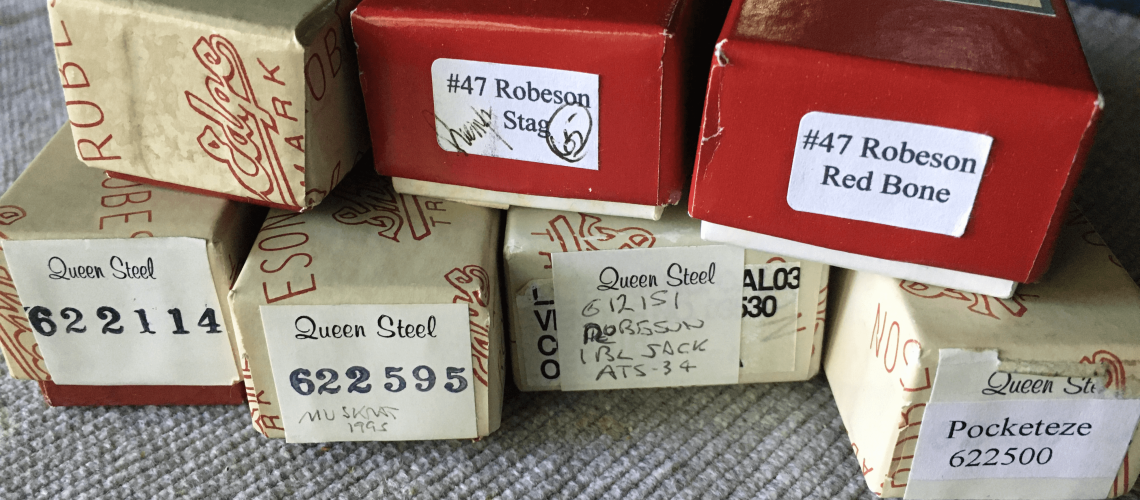Queen Robeson Boxes, 1993 -2017
David Krauss and Dan Lago
Servotronics Corporation of Buffalo New York bought the Ontario Knife Company in 1967. So, from that time Ontario owned the Robeson trademark. The original Robeson factory in Perry, NY, factory had closed in 1965, one year after it had been purchased by Cutler Federal Corporation. which continued to produce Robeson knives under contract with Camillus Cutlery until the marque was sold to Ontario. Ontario continued to produce or market Robeson brand knives until 1977 when the brand name went dormant. It would be not be until 1993 that the Robeson trademark would be used again, thanks to Servotronics’ acquisition of Queen Cutlery in 1969.
When Queen Cutlery started to have success in making new “old fashioned” pocket knives under the “Case Classics” brands for James Parker, and finally launched its highly successful Schatt & Morgan line, Servotronics management agreed to allow Queen to use the Robeson name and banked on Robeson’s former reputation to expand Queen’s success in “old fashioned” pocket knife production. Queen began making Robeson-marked knives, and, as noted above, they first appeared in the 1993 catalog with four patterns in Robeson’s famous “Strawberry Bone.”
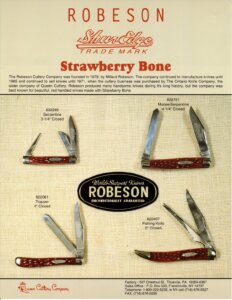
Figure 1. Queen Cutlery 1993 sales flier for Robeson Strawberry Bone.
Queen would make 20 different cataloged patterns over the next few years, including a highly regarded “Pocketeze” series in 1999-2001. 2001 was the last year the marque appeared in any of their yearly catalogs. From 2002 until 2017, they only released this brand in limited editions of 200 knives, or occasionally 100 knives. They always treated the brand as very high-end, equivalent to their flagship Schatt & Morgan knives, with premium steels and very fine fit and finish.
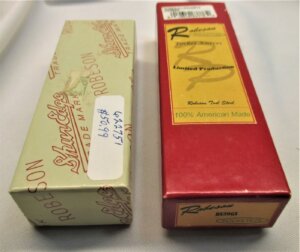
Figure 2. Robeson boxes. The lighter-colored box on the left was used for most early Robeson knives, showing the ShurEdge logo and Company name, from the mid ’90s. It is the most common Robeson box. This box also demonstrates how sellers might add handwritten or other labels on a box as secondary sellers. Sometimes this is useful. This particular label is helpful in that it includes a model number which could be checked against the tang stamp of the knife enclosed. If not consistent, it means the box may have been added to support the value of the knife. © Photo by Dan Lago.
The box on the right in Figure 2, was used with the Robeson Pocketeze knives and subsequent Daniels era Queen Special projects into the mid 2000’s. The boxes also provided an end-label with the model number included, so its’ connection with the knife inside can be checked.
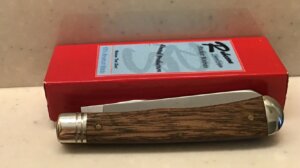
Figure 3. This “blue label” Robeson box is specific to some “ShurEdge” knives, and while not shown in this image, also includes a model # on the end. We are not sure when this blue-labeled box was first used, but estimate about 2008 until 2017. © Photo by anonymous, from a Facebook site.
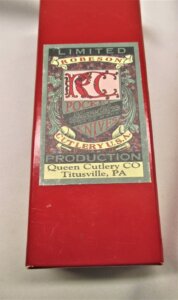
Figure 4. Deep red boxes with the ornate label, in small, medium, and large sizes to fit the enclosed knife were used from the mid 2000’s till the end of production in 2017. Both “ShurEdge” and “Mastercraft” brands were shipped in these boxes.
© Photo by Dan Lago.
As we showed in the article on Queen boxes 2000-2012, Bill Howard designed the Schatt & Morgan labels for the years 2004-2006. He was also responsible for designing the attractive Robeson label shown in Figure 4, in 2006, and it was used until Queen closed its doors in 2017.
Note some unusual examples of labeling below. Queen used various labels; the earliest (through the 1990s) are stamped with the Robeson model number, but using the readily available “Queen Steel” labels. It appears that after Queen had access to computer printing, they began to print information on blank labels in a more uniform manner, such as the famous #47, shown below. All labels were applied by hand at the factory to identify the knife in the box.
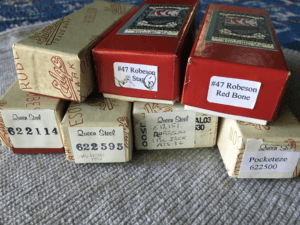
Figure 5. End Labels for Robeson boxes, 1990s, showing use of “Queen Steel” labels, and newer mid-2000s, with printed labels for #47 “Humpback Whittlers”, and a box with no label. © Photo by David Krauss
The Robeson boxes show a pattern of using red colors, contrary to the many different colors used for Queen and Schatt & Morgan knives over the years. It may be that this is a kind of remembrance of the famous Robeson use of “strawberry Bone” in their later years. This is not to say at the very end of Queen Cutlery, other box colors may have been used due to financial circumstances. To our knowledge, Queen/Robeson knives were always sold in a box, unlike some (non-series) Schatt and Morgan knives in the last years.
References
https://robesonrme.com/history.php
Kalcevic, Tom (2000). Knives Can Talk. The Story of the Robeson Cutlery Co.: as told from their knives, cutlery products, and local history
(second edition) TK Publishing. P.O. Box 351, Avon, NY.
Kalcevic, Tom (2012). Robeson Collectables and Rarities. TK Publishing. P.O. Box 351, Avon, NY. (Chapter on “the Road to Today 1994-2012”)
Krauss, David (2002). American Pocketknives A History of Schatt & Morgan, and Queen Cutlery. Chapter 23, “Robeson Cutlery”, pp.185-192. Krauss Publications, 3260 Euclid Height, Cleveland Heights, Ohio 44118.

